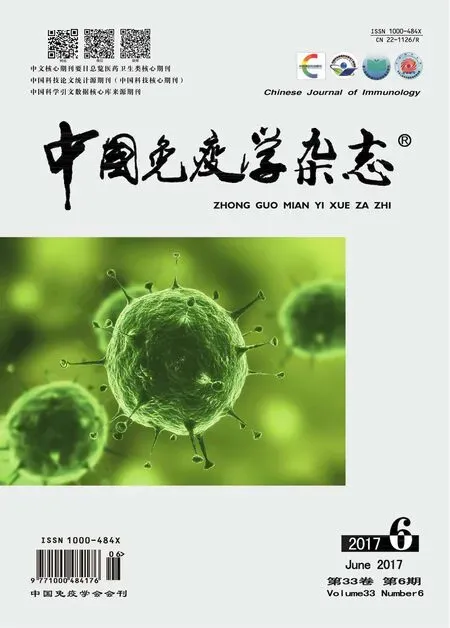树突状细胞与轮状病毒相互作用机制研究进展①
叶丽萍 胡静涛 王春凤
(吉林农业大学动物科学技术学院,长春130118)
树突状细胞与轮状病毒相互作用机制研究进展①
叶丽萍 胡静涛 王春凤
(吉林农业大学动物科学技术学院,长春130118)
轮状病毒(Rotavirus,RV)属于呼肠孤病毒科轮状病毒属成员,是引起婴幼儿和其他幼龄动物腹泻的主要病原之一,全世界每年约有400 000名儿童因感染此病毒而死亡[1]。RV感染已成为全球性的健康问题,各国研究人员对其感染的特点、免疫反应及疫苗开发做了大量的研究[2-4]。RV感染机体首先入侵肠道,以肠道黏膜免疫为主诱导机体免疫应答[5,6],但其免疫机理目前尚未完全清楚,研究RV感染的黏膜免疫机制将对疫苗的开发和疾病的防治至关重要。黏膜免疫是连接固有免疫和获得性免疫的桥梁,其中树突状细胞(Dendritic cells,DCs)作为重要的抗原递呈细胞(Antigen presentation cells,APC)起着衔接固有免疫和获得性免疫的关键免疫分子作用[7,8]。本文就RV感染对DCs的影响及相互作用机制的研究做一综述。
1 与RV感染相关的DCs分类
RV感染机体主要入侵肠道上皮细胞而导致肠绒毛损伤,肠道DCs的表型各不相同,但多以CD11chighMHCⅡhighDCs为主[9]。根据胃肠道淋巴结、派氏集合淋巴结(Peyer′s patch,PP)等是否表达CD11b和CD8α,将DCs分为CD11c+CD11b+CD8α-、CD11c+CD11b-CD8α+、CD11c+CD11b-CD8α-及CD11c+CD11cintCD8α+B220+四个亚群[10]。肠道中CD103+DCs还可分为CD103+CD11b+和CD103+CD11b-两个亚群,CD103+CD11b+DCs具有分泌淋巴细胞并促进T细胞产生免疫应答作用[9];而小肠黏膜固有层(Lamina propria,LP)中的CD103+DCs主要是CD11chiCD11bhiDCs亚群,能特异表达TLR5和诱导固有B细胞分化IgA+类浆细胞[11]。除此,Henri等[12]发现小鼠肠系膜淋巴结(Mesenteric lymph nodes,MLN)中存在CD11b+CD4+和CD4-CD8-DEC-205intDCs亚群。
2 RV感染与DCs相互作用机制
DCs对肠黏膜部入侵的病原体起到免疫识别、免疫应答和免疫调节作用,其数量和成熟状态直接影响肠道免疫应答能力。当肠道发生感染,源于多能造血干细胞的未成熟DCs(Immature DCs,IDCs)通过外周血液循环进入淋巴组织,摄取抗原发育为成熟DCs(Mature DCs,MDCs)并促进T、B淋巴细胞产生相应的免疫应答。RV与DCs相互作用是诱导还是抑制DCs成熟,DCs如何在抗RV感染中起着衔接固有免疫和获得性免疫关键分子作用,学者们做了大量研究。
2.1RV感染诱导/抑制DCs活化成熟 正常情况下绝大多数组织和器官内的DCs属于IDCs,起到免疫监视作用,低表达共刺激分子CD80、CD86、CD40和MHCⅡ。当病原体侵入机体,DCs被活化为MDCs抗原递呈能力增强,能够有效的将处理的抗原递呈给初始T细胞使之活化,从而启动免疫应答[13,14]。DCs成熟主要表现为共刺激分子的表达上调,趋化因子受体和细胞因子产生的变化,涉及到的信号通路包括NF-κB/IκBα、PI3K/Akt、MAPK/Erk/p38和MyD88/IRFs[14,15]。作者研究表明猪轮状病毒DN30209株能诱导小鼠BMDCs的成熟与活化,上调表达MHCⅡ和共刺激分子CD40、CD80、CD86,DCs的抗原递呈能力增强,通过TLR3/TRIF/NF-κB信号和TLR2/MyD88/NF-κB信号通路参与免疫应答。
RV感染促进DCs活化成熟还是导致细胞凋亡仍无定论。Narvaez等[16]研究认为RRV不诱导IDCs和MDCs凋亡,能诱导大约20%的IDCs成熟但不会改变MDCs的表型变化;互作用24 h后MDCs较IDCs表达更多的CD83和NSP4,表明RRV易感染MDCs。Istrate等[17]认为活的牛轮状病毒RF-81株(RFV)、RF 2/6-GFP-VLP和RF 8*2/6/7-VLP中RFV能上调共刺激分子CD86的表达,刺激骨髓树突细胞(Bone marrow-derived dendritic cells ,BMDCs)活化成熟,而且RFV能在BMDCs中表达病毒蛋白。Rodriguez等[18]的研究发现,RRV感染Caco-2细胞上清液刺激IDC 与单纯用RRV刺激IDC HLA-DR和CD86表达明显增加;单纯用RRV刺激IDCs可以提高CD83、HLA-DR、CD86的表达。Rosales-Martinez等[19]的研究则认为恒河猴轮状病毒(Rhesus monkey rotavirus,RRV)能活化新生儿脐带血(Umbilical cord blood,UCB)DCs,上调表达CD40、CD86和MHCⅡ,流式细胞术检测发现2% UCB DCs和28% PB DCs感染RRV。Mesa等[20]的研究认为mDC和pDC与RRV作用的初期即被感染,pDC能产生RV特异性记忆性T细胞参与免疫反应。
2.2RV感染的Toll样受体信号通路 Toll样受体(Toll-like receptors,TLRs)作为重要的病原体相关分子模式(Pathogen-associated molecular patterns, PAMP),其信号通路在诱导DCs成熟及激活固有免疫应答过程中起着重要作用[21,22]。RV感染时单核细胞表达的TLRs可通过识别dsRNA激活NF-κB和干扰素途径,导致细胞因子及辅助刺激分子的释放,调节机体非特异性免疫应答[22]。Pott等[23]的研究认为RV感染后TLR3的表达量明显高于TLR2、TLR4、TLR6-9,且成年鼠Tlr3诱导的免疫反应能更有效地抑制RV复制。Rosales-Martinez等[19]研究认为RRV能上调表达UCB DCs中TLR3、TLR4,产生大量的下游细胞因子IL-6、IL-12/23p40、IL-10、TGF-β、TNF-α和IFN-β,诱导Th1类细胞反应参与免疫应答。除此RV感染还可能与TLR2、TLR7、TLR8和TLR9参与并诱导致病后的免疫应答有关[24,25]。
TLRs通过激活下游核转录因子(NF-κB)和干扰素调节因子3(IFR3)等诱导DCs分泌细胞因子和Ⅰ型干扰素,激活固有免疫应答[22,26]。NF-κB的活化可以诱导多种抗炎细胞因子的分泌,刺激初始型CD4+T和CD8+T淋巴细胞,所以RV通过改变策略抑制NF-κB活化以保证病毒的复制[22,26]。Casola等[27]认为RV感染能诱导IκB激酶β(IKK-β)大量活化从而减少NF-κB基因转录利于RV的复制[28]。在感染初期RV可短暂地阻断STAT1、STAT2和NF-κB的活化逃避宿主固有免疫反应,但一些细胞因子可启动Jak-STAT信号途径增强机体的抗RV能力[29]。与TLR2、TLR4、TLR7、TLR8属于MyD88依赖型信号途径不同,TLR3进行MyD88非依赖型/TRIF依赖型的TLRs/NF-κB信号转导,诱导NF-κB晚期活化[26]。
2.3RV感染的干扰素途径 病毒感染可通过AMP与模式识别受体(Pattern recognition receptors,PRRs)结合,通过TLRs和RLR通路而启动干扰素调控因子(Interferon regulatory factor, IRF),进一步表达Ⅰ型IFNs(IFN-α和IFN-β)或Ⅱ型IFN(IFN-γ)参与抗病毒感染反应[29]。IFN信号转导通路主要通过启动JAK-STAT或PI3K、PKC、MAP激酶途径分泌大量细胞因子产生抗病毒作用。NSP1与磷脂酰肌醇激酶-3(PI3K)亚基P85相互作用进而活化抗细胞凋亡 PI3K/Akt通路,这一通路的活化有利于RV的复制[30,31]。Douagi等[32]的研究则认为RRV和UV-treated RV均能促进mDCs 活化和产生Ⅰ型IFN,RRV刺激mDCs上调表达CD40也依赖于Ⅰ型IFN信号途径,且Ⅰ型IFN的产生不经过TLR依赖信号途径。此外RV感染后NSP1通过蛋白激酶降解IRF3、IRF5和IRF7阻断Ⅰ型IFN转录,逃避宿主固有免疫反应[33,34]。恒河猴轮状病毒RRV和人轮状病毒Wa株通过抑制STAT1和STAT2的核聚集对抗天然免疫过程中Ⅰ型和Ⅱ型IFN作用[29]。Sen等[35]认为RV通过蛋白激酶R(PKP)依赖途径分泌IFN-β,细胞缺乏PKR会导致IFN-β分泌量减少,机体抗RV反应依赖线粒体抗病毒信号蛋白(MAVS/IPS-1)、维甲酸诱导基因IRIG-Ⅰ、黑色素瘤分化相关基因5(MDA-5)和IRF3的参与。
最近的研究表明包括IFN-λ1(IL-29),IFN-λ2(IL-28A)和IFN-λ3(IL-28B)的Ⅲ型IFNs也在固有免疫反应中起着重要作用[36]。与IFN-αβ-R-/-型和野生型小鼠比较IFN-λ缺陷小鼠更易受到RV感染验证了上述观点,成年小鼠IFN-λ表达需要完整的Tlr3/Trif信号[34]。总之RV感染机体Ⅰ型IFNs(IFNα/β)和Ⅲ型IFN(IFN-λ)都起着重要的抗病毒作用,它们的作用大小取决于病毒株的自然状态、病毒复制部位、IFN-λ的协同效应、病毒复制持续的时间及宿主的年龄等因素[37]。
2.4RV感染介导T细胞、B细胞免疫反应 DCs根据来源不同分为主要表达CD11c+的髓细胞来源DCs(DC1)和CD123+的浆细胞来源DCs(DC2)。DC1成熟活化后分泌大量IL-12、IL-β、IL-2α、IL-6、IL-10等促炎性细胞因子,促使CD4+T细胞向Th1分化;而DC2活化后主要分泌IL-8促使CD4+T细胞向Th2分化[38,39],CD4+T细胞及其分泌的相关细胞因子能有效防止RV的再次感染。Jiang等[39]检测婴幼儿急性RV感染IL-1β、IL-2、IL-4、IL-6、IL-10、IL-12、IFN-γ、TNF-α的变化情况,结果IL-6、IL-10和IFN-γ表达量明显增高,暗示RV自然感染时Th1和Th2类细胞因子都发挥作用且急性感染后期以IL-12和IFN-γ为主的Th1 类细胞反应为主[40]。Wang等[41]研究认为,Wa株RV感染细胞能诱导TLR4、TLR5、TLR7和TLR9基因活化并刺激下游IFN-α、IFN-β、TNF-α、IL-6、IL-8和IL-17细胞因子的表达,参与细胞免疫应答。Narvaez等[16]的研究认为RV感染DCs不诱导IDC和MDC死亡,促进IDC分泌IL-6,但IL-1β、 IL-8、 IL-10、 IL-12、TNF-α、IFN-β分泌较少;MDC分泌IL-6和少量的IL-10和IL-12p70。
B细胞在抗RV感染中也起着重要作用,RV感染小鼠的脾脏和骨髓中IgG和IgA表达B细胞利于RV的清除,急性感染期黏膜B细胞也参与免疫反应[42]。Fenaux等[40]研究发现,RRV感染小鼠MLN中可检测到大量感染的B细胞和DCs,且NSP4阳性细胞能表达pDCs 标志分子B220、mDCs 标志分子CD11c以及CD11b。Deal等[43]的研究认B细胞识别的Ⅰ型IFN对RV调节的B细胞活化至关重要,RV感染鼠小肠中pDCs和IFN-α/β参与B细胞活化,RV刺激的pDCs与αIFN-α共培养能明显增加CD69+B细胞的表达。Pane等[44]的研究则认为RRV感染后B细胞的活化需要CD11c+DC的参与,Ⅰ型IFN能直接增加DCs和B细胞向T细胞递呈抗原的能力。
3 展望
综上所述,DC通过摄取、处理、递呈病毒粒子并产生相应的免疫应答,参与机体的抗RV感染作用。但是,病原体会通过抑制DC成熟、改变体内DC数量、促进DC凋亡、阻止DC迁移等多种方式逃避机体的免疫识别。随着对RV感染免疫机制的不断深入研究,细胞免疫和体液免疫的研究取得了巨大进展,但对RV感染的天然免疫和肠道黏膜免疫研究相对较少。更加深入地研究RV感染与宿主细胞互作机制、RV感染对DC的影响将更全面的了解RV感染致肠炎的发病机理及抗RV感染天然免疫机制,对有效预防RV感染,促进抗RV疫苗的研发具有重要意义。
[1] Cherian T,Wang S,Mantel C.Rotavirus vaccines in developing countries:the potential impact,implementation challenges,and remaining questions[J].Vaccine,2012,30(Suppl 1):A3-A6.
[2] Cevallos PD,Lopez S,Arias CF,etal.Polarized rotavirus entry and release from differentiated small intestinal cells[J].Virology,2016,499:65-71.
[3] Gruber JF,Hille DA,Liu GF,etal.Heterogeneity of rotavirus vaccine efficacy among infants in developing countries[J].Pediatric Infect Dis J,2016,36(1):72-78.
[4] Glass RI,Parashar UD,Bresee JS,etal.Rotavirus vaccines:current prospects and future challenges[J].Lancet,2006,368(9532):323-332.
[5] Wang J,Hu G,Gao W,etal.Immortalized porcine intestinal epithelial cell cultures susceptible to porcine rotavirus infection[J].J Virol Methods,2014,202:87-94.
[6] Li M,Monaco MH,Wang M,etal.Human milk oligosaccharides shorten rotavirus-induced diarrhea and modulate piglet mucosal immunity and colonic microbiota[J].ISME J,2014,8(8):1609-1620.
[7] Lee HK,Iwasaki A.Innate control of adaptive immunity:dendritic cells and beyond[J].Semin Immunol,2007,19(1):48-55.
[8] Ke N,Su A,Huang W,etal.Regulating the expression of CD80/CD86 on dendritic cells to induce immune tolerance after xeno-islet transplantation[J].Immunobiology,2016,221(7):803-812.
[9] Denning TL,Norris BA,Medina-Contreras O,etal.Functional specializations of intestinal dendritic cell and macrophage subsets that control Th17 and regulatory T cell responses are dependent on the T cell/APC ratio,source of mouse strain,and regional localization[J].J Immunol,2011,187(2):733-747.
[10] Bilsborough J,Viney JL.Gastrointestinal dendritic cells play a role in immunity,tolerance,and disease[J].Gastroenterology,2004,127(1):300-309.
[11] Fujimoto K,Karuppuchamy T,Takemura N,etal.A new subset of CD103+CD8alpha+dendritic cells in the small intestine expresses TLR3,TLR7,and TLR9 and induces Th1 response and CTL activity[J].J Immunol,2011,186(11):6287-6295.
[12] Henri S,Vremec D,Kamath A,etal.The dendritic cell populations of mouse lymph nodes[J].J Immunol,2001,167(2):741-748.
[13] Liu K,Nussenzweig MC.Origin and development of dendritic cells[J].Immunol Rev,2010,234(1):45-54.
[14] Xu WD,Wang J,Yuan TL,etal.Interactions between canonical Wnt signaling pathway and MAPK pathway regulate differentiation,maturation and function of dendritic cells[J].Cell Immunol,2016,310:170-177.
[15] Hu Y,Parkmin KH,Yarilina A,etal.Regulation of STAT pathways and IRF1 during human dendritic cell maturation by TNF-alpha and PGE2[J].J Leukoc Biol,2008,84(5):1353-1360.
[16] Narvaez CF,Angel J,Franco MA.Interaction of rotavirus with human myeloid dendritic cells[J].J Virol,2005,79(23):14526-14535.
[17] Istrate C,Douagi I,Charpilienne A,etal.Bone marrow dendritic cells internalize live RF-81 bovine rotavirus and rotavirus-like particles(RF 2/6-GFP-VLP and RF 8*2/6/7-VLP)but are only activated by live bovine rotavirus[J].Scand J Immunol,2007,65(6):494-502.
[18] Rodriguez LS,Narvaez CF,Rojas OL,etal.Human myeloid dendritic cells treated with supernatants of rotavirus infected Caco-2 cells induce a poor Th1 response[J].Cell Immunol,2012,272(2):154-161.
[19] Rosales-Martinez D,Gutierrez-Xicotencatl L,Badillo-Godinez O,etal.Rotavirus activates dendritic cells derived from umbilical cord blood monocytes[J].Micro Pathog,2016,99:162-172.
[20] Mesa MC,Rodriguez LS,Franco MA,etal.Interaction of rotavirus with human peripheral blood mononuclear cells:plasmacytoid dendritic cells play a role in stimulating memory rotavirus specific T cells in vitro[J].Virology,2007,366(1):174-184.
[21] Liang J,Fu J,Kang H,etal.The stimulatory effect of TLRs ligands on maturation of chicken bone marrow-derived dendritic cells[J].Vet Immunol Immunopathol,2013,155(3):205-210.
[22] Lopez S,Sanchez-Tacuba L,Moreno J,etal.Rotavirus strategies against the innate antiviral system[J].Annu Rev Virol,2016,3(1):591-609.
[23] Pott J,Stockinger S,Torow N,etal.Age-dependent TLR3 expression of the intestinal epithelium contributes to rotavirus susceptibility[J].PLoS Pathog,2012,8(5):e1002670.
[24] Xu J,Yang Y,Sun J,etal.Expression of Toll-like receptors and their association with cytokine responses in peripheral blood mononuclear cells of children with acute rotavirus diarrhoea[J].Clin Exp Immunol,2006,144(3):376-381.
[25] Lopez-Guerrero DV,Meza-Perez S,Ramirez-Pliego O,etal.Rotavirus infection activates dendritic cells from Peyer′s patches in adult mice[J].J Virol,2010,84(4):1856-1866.
[26] Liu K,Yang X,Wu Y,etal.Rotavirus strategies to evade host antiviral innate immunity[J].Immunol Lett,2009,127(1):13-18.
[27] Casola A,Garofalo RP,Crawford SE,etal.Interleukin-8 gene regulation in intestinal epithelial cells infected with rotavirus:role of viral-induced IkappaB kinase activation[J].Virology,2002,298(1):8-19.
[28] Alaniz RC,Sandall S,Thomas EK,etal.Increased dendritic cell numbers impair protective immunity to intracellular bacteria despite augmenting antigen-specific CD8+T lymphocyte responses[J].J Immunol,2004,172(6):3725-3735.
[29] Holloway G,Truong TT,Coulson BS.Rotavirus antagonizes cellular antiviral responses by inhibiting the nuclear accumulation of STAT1,STAT2,and NF-kappaB[J].J Virol,2009,83(10):4942-4951.
[30] Bagchi P,Bhowmick R,Nandi S,etal.Rotavirus NSP1 inhibits interferon induced non-canonical NFkappaB activation by interacting with TNF receptor associated factor 2[J].Virology,2013,444(1-2):41-44.
[31] Bagchi P,Dutta D,Chattopadhyay S,etal.Rotavirus nonstructural protein 1 suppresses virus-induced cellular apoptosis to facilitate viral growth by activating the cell survival pathways during early stages of infection[J].J Virol,2010,84(13):6834-6845.
[32] Douagi I,McInerney GM,Hidmark AS,etal.Role of interferon regulatory factor 3 in type I interferon responses in rotavirus-infected dendritic cells and fibroblasts[J].J Virol,2007,81(6):2758-2768.
[33] Sen A,Feng N,Ettayebi K,etal.IRF3 inhibition by rotavirus NSP1 is host cell and virus strain dependent but independent of NSP1 proteasomal degradation[J].J Virol,2009,83(20):10322-10335.
[34] Pott J,Mahlakoiv T,Mordstein M,etal.IFN-lambda deter mines the intestinal epithelial antiviral host defense[J].Proc Natl Acad Sci U S A,2011,108(19):7944-7949.
[35] Sen A,Pruijssers AJ,Dermody TS,etal.The early interferon response to rotavirus is regulated by PKR and depends on MAVS/IPS-1,RIG-I,MDA-5,and IRF3[J].J Virol,2011,85(8):3717-3732.
[36] Donnelly RP,Kotenko SV.Interferon-lambda:a new addition to an old family[J].J Interferon Cytokine Res,2010,30(8):555-564.
[37] Sen A,Rothenberg ME,Mukherjee G,etal.Innate immune response to homologous rotavirus infection in the small intestinal villous epithelium at single-cell resolution[J].Proc Natl Acad Sci U S A,2012,109(50):20667-20672.
[38] Ma X,Yan W,Zheng H,etal.Regulation of IL-10 and IL-12 production and function in macrophages and dendritic cells[J].F1000Res,2015,4:F1000.
[39] Jiang B,Snipes-Magaldi L,Dennehy P,etal.Cytokines as mediators for or effectors against rotavirus disease in children[J].Clin Diagn Lab Immunol,2003,10(6):995-1001.
[40] Fenaux M,Cuadras MA,Feng N,etal.Extraintestinal spread and replication of a homologous EC rotavirus strain and a heterologous rhesus rotavirus in BALB/c mice[J].J Virol,2006,80(11):5219-5232.
[41] Wang H,Moon S,Wang Y,etal.Multiple virus infection alters rotavirus replication and expression of cytokines and Toll-like receptors in intestinal epithelial cells[J].Virus Res,2012,167(1):48-55.
[42] Wen K,Bui T,Weiss M,etal.B-cell-deficient and CD8 T-cell-depleted gnotobiotic pigs for the study of human rotavirus vaccine-induced protective immune responses[J].Viral Immunol,2016,29(2):112-127.
[43] Deal EM,Lahl K,Narvaez CF,etal.Plasmacytoid dendritic cells promote rotavirus-induced human and murine B cell responses[J].J Clin Invest,2013,123(6):2464-2474.
[44] Pane JA,Webster NL,Zufferey C,etal.Rotavirus acceleration of murine type 1 diabetes is associated with increased MHC class I-restricted antigen presentation by B cells and elevated proinflammatory cytokine expression by T cells[J].Virus Res,2014,179:73-84.
[收稿2016-09-03 修回2016-11-05]
(编辑 许四平)
10.3969/j.issn.1000-484X.2017.06.030
①本文受国家“863”计划项目(2013AA102806)、国家自然科学基金项目(31272541, 31272552)和吉林省科技发展计划项目(20160519011)资助。
叶丽萍(1975年-),女,硕士,高级实验师,主要从事动物微生态学与动物黏膜免疫方面的研究,E-mail: yeliping1114@163.com。
及指导教师:王春凤(1972年-),女,博士,教授,主要从事动物微生态学与动物黏膜免疫方面的研究, E-mail: wangchunfeng@jlau.edu.cn。
S852.65+9.4
A
1000-484X(2017)06-0947-04

